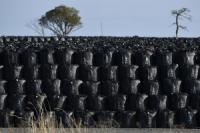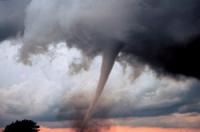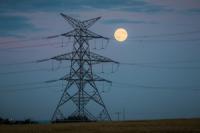-
U.S. nuclear watchdog greatly underestimates potential for nuclear disaster

The U.S. Nuclear Regulatory Commission (NRC) relied on faulty analysis to justify its refusal to adopt a critical measure for protecting Americans from the occurrence of a catastrophic nuclear-waste fire at any one of dozens of reactor sites around the country, a new study shows. Fallout from such a fire could be considerably larger than the radioactive emissions from the 2011 Fukushima accident in Japan. These catastrophic consequences, which could be triggered by a large earthquake or a terrorist attack, could be largely avoided by regulatory measures that the NRC refuses to implement.
-
-
Tornado damage impact could triple in coming decades

Tornadoes are one of the most unpredictable weather phenomena on Earth. Each year the United States, home to more tornadoes than any other country, sustains billions of dollars of damage, death, injuries, and disruption from the violent storms. Scientists say that the potential for annual tornado impact magnitude and disaster could triple by the end of the twenty-first century.
-
-
New funding enables work on Internet policy and cybersecurity for key infrastructure
MIT’s cross-disciplinary Internet Policy Research Initiative (IPRI) announced that it has awarded $1.5 million to a select group of principal investigators for early-stage Internet policy and cybersecurity research projects. “Understanding the nuance of cybersecurity risk in our critical infrastructure will help policymakers assure that the proper incentives are in place to reduce the threat of catastrophic attacks,” says IPRI founding director Daniel Weitzner.
-
-
The Hindenburg: It was not hydrogen's fault!
Eighty years ago this month, on 6 May 1937, the German passenger airship LZ 129 Hindenburg caught fire and was destroyed as it was attempting to dock with its mooring mast at Naval Air Station Lakehurst in Manchester Township, New Jersey. Current information indicates that it was not the gas but a coating on the dirigible’s skin that was primarily responsible for the disaster.
-
-
New tool could help predict, prevent surging waters in flood plains
A group of international scientists studying China’s Yellow River has created a new tool that could help officials better predict and prevent its all-too-frequent floods, which threaten as many as eighty million people. The tool — a formula to calculate sediment transport — may also be applied to studying the sustainability of eroding coastlines worldwide.
-
-
Right research, development investments “good bets” for both climate and economies
Investing in new ways of utility-scale electricity storage and capturing carbon to store underground should be a priority for governments aiming to meet the greenhouse gas and “green energy” targets set out in the Paris Agreement despite shrinking research and development budgets, experts suggest. Researchers analyzed a range of studies and expert reports on public energy R&D investments to uncover common threads and trends — pulling together the current state of knowledge on cost-effective investments across a range of energy technologies.
-
-
New plutonium discovery to help nuclear waste clean-up
Plutonium has long been part of many countries’ nuclear energy strategies, but scientists are still unlocking the mysteries behind this complicated element and seeing how they can use heavier, nuclear elements to clean up nuclear waste. Now, new research shows that plutonium does not exactly work the way scientists thought it did. The findings will contribute to the effort to develop technologies to clean up nuclear waste.
-
-
Helping power utilities and others better plan for the future
If you’re an electric utility planning a new power plant by a river, it would be nice to know what that river will look like twenty years down the road. Will it be so high that it might flood the new facility? Will the water be so low that it can’t be used to cool the plant? Generally, such projections have been based on records of past precipitation, temperature, flooding and other historical data. But in an era when temperature and precipitation are changing rapidly, historical patterns won’t do you much good. A new initiative by the U.S. Department of Energy’s (DOE) Argonne National Laboratory combines climate data and analysis with infrastructure planning and decision support, promises real help.
-
-
New water filtration technology uses 1,000 times less energy
With global demand for clean water increasing, there is a continuing need to improve the performance of water treatment processes. A new process for water filtration using carbon dioxide consumes one thousand times less energy than conventional methods, scientific research published this week has shown.
-
-
Wastewater injection rates triggered Oklahoma's largest earthquake
The 3 September 2016 magnitude 5.8 Pawnee quake, felt widely across Oklahoma, is the largest earthquake recorded in the state since the 1950s. Most Oklahoma earthquakes since 2009 are thought to have been triggered by wastewater produced by oil and gas drilling that has been injected back into the ground – and a new report says that changes to the rate of wastewater injection in disposal wells may have contributed to conditions that led to the Pawnee earthquake.
-
-
Solar power to reduce national security risks in the U.S. power grid
Vulnerabilities in the power grid are one of the most prevalent national security threats. The technical community has called for building up the resiliency of the grid using distributed energy and microgrids for stabilization. Power production from multiple sources increases the difficulty of triggering cascading blackouts, and following an attack or natural disaster, microgrids can provide localized energy security. Distributed microgrid tech can secure the electrical grids at military bases to reduce the impact of cyberattacks, physical attacks from terrorists, and natural disasters.
-
-
Nuclear storage tunnel collapses at Washington State’s Hanford site; employees evacuated
Hundreds of workers have been forced to “take cover” after a tunnel in a nuclear finishing plant collapsed at the Hanford Nuclear Reservation in southeastern Washington state. The Department of Energy activated its Emergency Operations Center following the collapse. Nuclear experts have criticized to storage and safety practices at the site, calling it “the most toxic place in America” and saying it was “an underground Chernobyl waiting to happen.”
-
-
Quickly detecting structural problems in bridges, dams
Today, there is great interest in using distributed sensors to continually monitor the structural health of large structures such as dams or bridges. With one million sensing points, a newly developed fiber optic distributed sensor could offer significantly faster detection of structural problems than is currently available.
-
-
Upgrading the U.S. grid

As society moves toward an increasingly connected world, keeping the U.S. electrical grid reliable and safe from hackers and other potential security threats has perhaps never been more crucial. The Department of Energy’s Grid Modernization Initiative aims to deliver fundamental knowledge, new concepts, tools and data to support the nation’s journey to modernizing the electric power system infrastructure. Enhanced grid security, grid flexibility via energy storage and improved economic competitiveness are key outcomes of this initiative.
-
-
Europe’s economy vulnerable to global water scarcity, drought
A new study of the impacts that increasing water scarcity and drought may have on the European Union’s (EU) economy finds that around 38 percent of the EU’s water demand lies outside its borders because many of the goods consumed by its citizens or used by its businesses are produced abroad. “The highest risk that the European meat and dairy sector will face due to climate change and weather extremes lies outside its borders. This is because it is highly dependent on soybean imports from locations that are vulnerable to water scarcity and drought,” says one expert.
-
- All
- Regional
- Water
- Biometrics
- Borders/Immig
- Business
- Cybersecurity
- Detection
- Disasters
- Government
- Infrastructure
- International
- Public health
- Public Safety
- Communication interoperabillity
- Emergency services
- Emergency medical services
- Fire
- First response
- IEDs
- Law Enforcement
- Law Enforcement Technology
- Military technology
- Nonlethal weapons
- Nuclear weapons
- Personal protection equipment
- Police
- Notification /alert systems
- Situational awareness
- Weapons systems
- Sci-Tech
- Sector Reports
- Surveillance
- Transportation
Advertising & Marketing: advertise@newswirepubs.com
Editorial: editor@newswirepubs.com
General: info@newswirepubs.com
2010-2011 © News Wire Publications, LLC News Wire Publications, LLC
220 Old Country Road | Suite 200 | Mineola | New York | 11501
Permissions and Policies
Editorial: editor@newswirepubs.com
General: info@newswirepubs.com
2010-2011 © News Wire Publications, LLC News Wire Publications, LLC
220 Old Country Road | Suite 200 | Mineola | New York | 11501
Permissions and Policies
